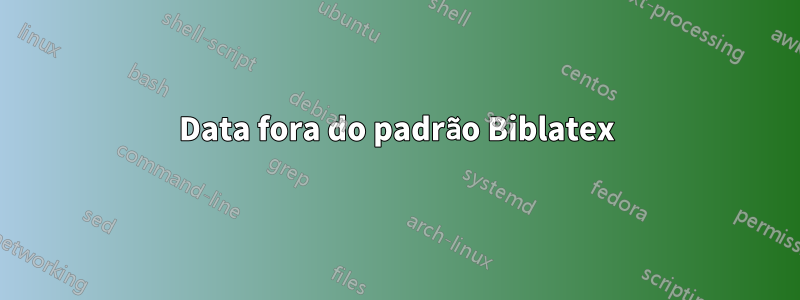
Estou usando biblatex e biber para referenciar trabalhos mostrados em uma aula de história. Dados em séculos (século XII ouSéculo XIIem francês) são bastante comuns. Eu costumava escrever essas datas no campo "Ano" e funcionou desde a última atualização:
A seguir o MWE compila com o TexLive 2015…
\documentclass{article}
\usepackage{biblatex}
\usepackage[utf8]{inputenc}
\usepackage{filecontents}
\begin{filecontents}{\jobname.bib}
@Thesis{exemple_image,
Title = {Title of the work},
Author = {Artist Name},
Location = {Switzerland},
Year = {{\siecle{15}}},
}
\end{filecontents}
\addbibresource{\jobname.bib}
\newcommand{\siecle}[1]{%
\textsc{\romannumeral #1}\textsuperscript{e}~siècle
}
\nocite{*}
\begin{document}
\nocite{*}
\printbibliography
\end{document}
…mas não mais com o TexLive 2016, onde recebi um erro: ! Use of /sortlist doesn't match its definition.
Acho que o Biblatex 3.5 é menos permissivo com o campo "Ano". Procurei na documentação sem sucesso e estou aberto a todas as sugestões.
Responder1
Com os novos recursos de data ISO 8601 de biblatex3.10 e superiores, você pode inserir um século como
date = {19XX}
Infelizmente, os formatos de data padrão não lidam com isso imediatamente, mostrando 'século 20' ou resultados semelhantes, eles apenas escreveriam '1900-1999', mas podemos permitir o tratamento de séculos da seguinte forma
\documentclass[french]{article}
\usepackage[T1]{fontenc}
\usepackage[utf8]{inputenc}
\usepackage{babel}
\usepackage{csquotes}
\usepackage{biblatex}
\usepackage{filecontents}
\begin{filecontents}{\jobname.bib}
@thesis{exemple_image,
title = {Title of the work},
author = {Artist Name},
location = {Switzerland},
date = {16XX},
}
\end{filecontents}
\addbibresource{\jobname.bib}
\NewBibliographyString{century}
\DefineBibliographyStrings{french}{century = {siècle}}
\makeatletter
\renewcommand*{\RNfont}{\textsc}
\DeclareFieldFormat{datecentury}{\RN{#1}\textsuperscript{e}}
\renewrobustcmd*{\mkdaterangetrunc}[2]{%
\begingroup
\blx@metadateinfo{#2}%
\iffieldundef{#2year}
{}
{\printtext[#2date]{%
\datecircaprint
% Such a season component can only come from an EDTF 5.1.5 season which replaces
% a normal month so if it exists, we know that a normal date print is ruled out
\iffieldequalstr{dateunspecified}{yearincentury}
{\printtext[datecentury]{\number\numexpr\thefield{#2year}/100+1\relax}\setunit{\addnbspace}\bibstring{century}}
{\iffieldundef{#2season}
{\iffieldsequal{#2year}{#2endyear}
{\iffieldsequal{#2month}{#2endmonth}
{\csuse{mkbibdate#1}{}{}{#2day}}
{\csuse{mkbibdate#1}{}{#2month}{#2day}}}
{\csuse{mkbibdate#1}{#2year}{#2month}{#2day}%
\iffieldsequal{#2dateera}{#2enddateera}{}
{\dateeraprint{#2year}}}}
{\iffieldsequal{#2year}{#2endyear}
{\csuse{mkbibseasondate#1}{}{#2season}}
{\csuse{mkbibseasondate#1}{#2year}{#2season}%
\iffieldsequal{#2dateera}{#2enddateera}{}
{\dateeraprint{#2year}}}}%
\dateuncertainprint
\iffieldundef{#2endyear}
{}
{\iffieldequalstr{#2endyear}{}
{\mbox{\bibdaterangesep}}
{\bibdaterangesep
\enddatecircaprint
\iffieldundef{#2season}
{\csuse{mkbibdate#1}{#2endyear}{#2endmonth}{#2endday}}
{\csuse{mkbibseasondate#1}{#2endyear}{#2endseason}}%
\enddateuncertainprint
\dateeraprint{#2endyear}}}}}}%
\endgroup}
\makeatother
\begin{document}
\nocite{*}
\printbibliography
\end{document}
Onde \iffieldequalstr{dateunspecified}{yearincentury}verifica um século, o formato datecenturycontrola a saída do século e a string bib centurypode ser usada para localizar ainda mais a saída.
Consulte também96-dates.texbem como §2.3.8Especificações de data e hora, §4.2.4.1Campos genéricosdea biblatexdocumentação.
Responder2
Basta mudar a maneira como você define \siecle:
\newrobustcmd{\siecle}[1]{%
\textsc{\romannumeral #1}\textsuperscript{e}~siècle
}
Desta forma a macro não é expandida prematuramente. Claro, o aviso
WARN - year field '{\siecle{15}}' in entry 'exemple_image' is not an integer - this will probably not sort properly.
vai aparecer mesmo assim.
Responder3
Outra forma é contar com Biber para mapear o yearcampo para outro campo. (Este exemplo usa addendum.) Não está claro no exemplo se você deseja ou precisa limitar o mapeamento de origem a um subconjunto específico de entradas, mas há diversas maneiras de fazer isso. (Este exemplo limita-se ao .bibarquivo específico e ao entrytype thesis, apenas como exemplo.)
Biber terminará sem avisos ou erros.
\documentclass{article}
\usepackage[utf8]{inputenc}
\usepackage{filecontents}
\begin{filecontents}{\jobname.bib}
@Thesis{exemple_image,
Title = {Title of the work},
Author = {Artist Name},
Location = {Switzerland},
Year = {{\siecle{15}}},
}
\end{filecontents}
\usepackage[backend=biber]{biblatex}
\addbibresource{\jobname.bib}
\newcommand{\siecle}[1]{%
\textsc{\romannumeral #1}\textsuperscript{e}~siècle
}
\DeclareSourcemap{
\maps[datatype=bibtex, overwrite]{
\map{
\perdatasource{\jobname.bib}% <-- If you have them in a special bib file
\pertype{thesis}% <-- If you want to limit by type
\step[fieldsource=year]
\step[fieldset=addendum, origfieldval]
\step[fieldset=year, null]
}
}
}
\nocite{*}
\begin{document}
\nocite{*}
\printbibliography
\end{document}





